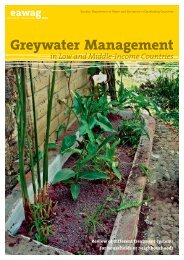Household Water Treatment and Safe Storage Factsheet: Source ...
Household Water Treatment and Safe Storage Factsheet: Source ...
Household Water Treatment and Safe Storage Factsheet: Source ...
Create successful ePaper yourself
Turn your PDF publications into a flip-book with our unique Google optimized e-Paper software.
<strong>Household</strong> <strong>Water</strong> <strong>Treatment</strong> <strong>and</strong> <strong>Safe</strong> <strong>Storage</strong><br />
Fact Sheet: Chlorine (NaDCC Tablets) Key Data<br />
Inlet <strong>Water</strong> Criteria<br />
Low turbidity<br />
pH between 5.5 <strong>and</strong> 7.5; disinfection is unreliable above a pH of 9<br />
<strong>Treatment</strong> Efficiency<br />
Bacteria Viruses Protozoa Helminths Turbidity<br />
Laboratory High 4 High 4 Low 4 Ineffective5 –<br />
Moderate 6 0%<br />
Field Not available Not available Not available Not available 0%<br />
1<br />
Bacteria include Burkholderia pseudomallei, Campylobacter jejuni, Escherichia coli, Salmonella typhi, Shigella<br />
dysenteriae, Shigella sonnei, Vibrio cholerae, Yersinia enterocolitica.<br />
2<br />
Viruses include enteroviruses, adenoviruses, noroviruses, rotavirus.<br />
3<br />
Protozoa include Entamoeba histolytica, Giardia lamblia, Toxoplasma gondii, Cryptosporidium parvum.<br />
4 CDC (2007)<br />
5 AWWA (2006) shows that chlorine is ineffective for Ascariasis lumbricoides ova.<br />
6 Mercado-Burgos et al.(1975) show moderate effectiveness for Schistosoma species. Assume moderate effectiveness for<br />
Dracunculus medinensis.<br />
<br />
Toxoplasma oocysts <strong>and</strong> Cryptosporidium parvum oocysts are highly resistant to chlorine<br />
disinfection (CDC, 2007). Chlorine alone should not be expected to inactivate these pathogens.<br />
Operating Criteria<br />
Flow Rate Batch Volume Daily <strong>Water</strong> Supply<br />
Not applicable Unlimited Unlimited<br />
Need to follow manufacturer’s instructions for specific NaDCC products<br />
Required dose <strong>and</strong> contact time varies with turbidity, pH <strong>and</strong> temperature (Lantagne, 2009)<br />
Very turbid water should be sedimented or filtered prior to chlorination<br />
Use a 30-minute minimum contact time<br />
Robustness<br />
<br />
<br />
<br />
<br />
Free residual chlorine protects against recontamination<br />
Most users cannot determine the dosing themselves; need to follow manufacturer instructions<br />
Users may use less than the recommended dose to save money<br />
Requires supply chain, market availability <strong>and</strong> regular purchase<br />
Estimated Lifespan<br />
Five year shelf-life in strip packs <strong>and</strong> a three year shelf-life in tubs (Medentech, 2009)<br />
Manufacturing Requirements<br />
Worldwide Producers:<br />
Medentech Ltd. manufactures Aquatabs for water disinfection, hospital surface infection<br />
control <strong>and</strong> general environmental disinfection<br />
Local Production:<br />
NaDCC tablets cannot be produced locally, but they can be bought in bulk <strong>and</strong> packaged<br />
locally<br />
Materials:<br />
Tablets <strong>and</strong> packaging materials<br />
Fabrication Facilities:<br />
Workshop space for packaging the tablets
















